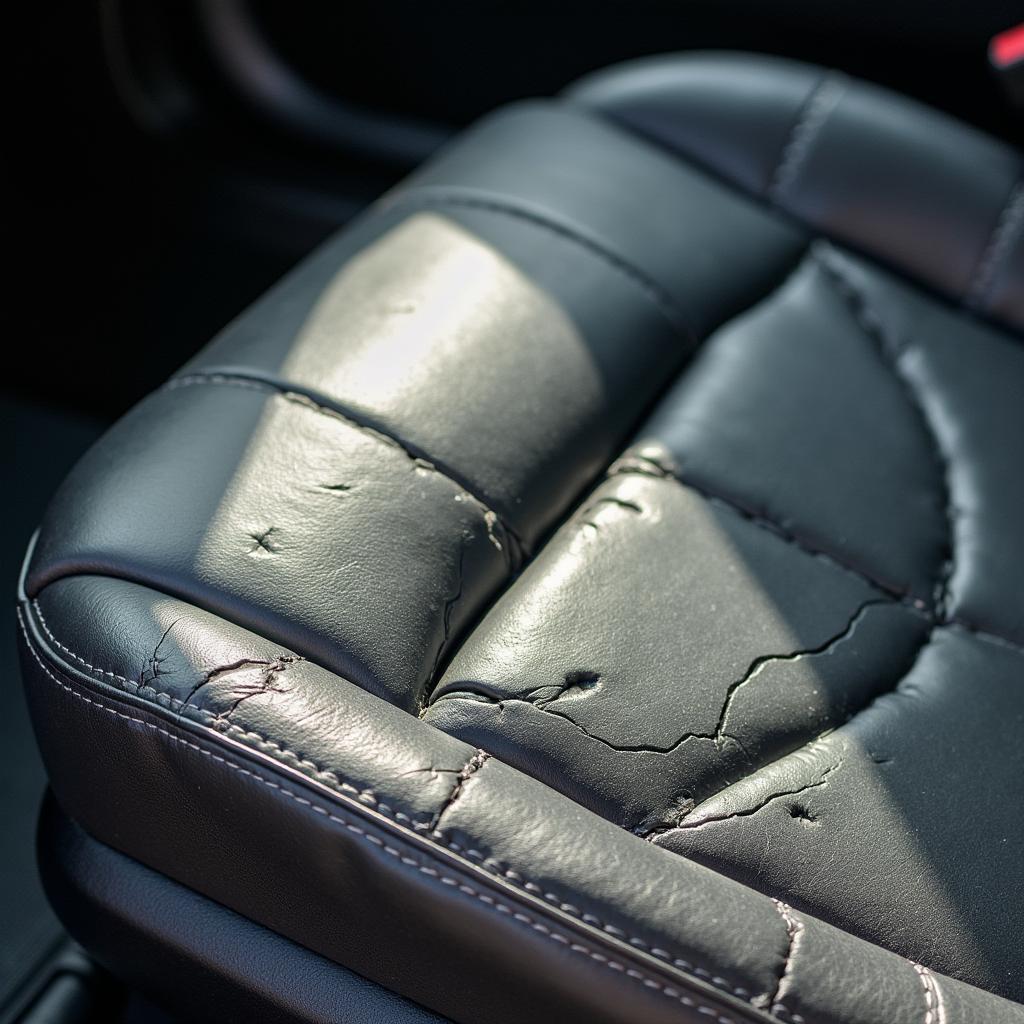Leather car seats add a touch of luxury and sophistication to any vehicle. But over time, exposure to heat, sunlight, and everyday wear and tear can cause cracks to appear in the leather. These cracks not only detract from the appearance of your car’s interior but can also diminish the value of your vehicle. Fortunately, you don’t need to be an automotive expert to learn how to repair car leather seat cracks and restore them to their former glory.
This comprehensive guide will walk you through the process step-by-step, providing you with all the information and tips you need to achieve professional-looking results.
Understanding the Causes of Car Leather Seat Cracks
Before we delve into the repair process, it’s important to understand what causes car leather seat cracks in the first place. This knowledge will not only help you address the current damage but also prevent future cracks from forming.
-
Sun Damage: Prolonged exposure to the sun’s harmful UV rays is one of the primary culprits behind leather cracking. UV radiation dries out the leather, causing it to become brittle and prone to cracking.
-
Heat: Excessive heat, similar to sun damage, can also dry out leather, making it more susceptible to cracking. Leaving your car parked in direct sunlight on a hot day can create an oven-like environment inside, accelerating the damage.
-
Lack of Maintenance: Just like your skin, leather needs regular moisturizing to stay supple. Neglecting to clean and condition your leather seats can lead to dryness, cracking, and premature aging.
-
Wear and Tear: Constant rubbing, friction, and pressure from getting in and out of your car can weaken the leather over time, eventually leading to cracks in high-stress areas.
Assessing the Damage: Minor Cracks vs. Major Tears
The repair method you choose will depend on the severity of the damage to your leather car seats.
-
Minor Cracks and Scratches: Superficial cracks and scratches that don’t penetrate deep into the leather can often be repaired using simple DIY methods and readily available repair kits.
-
Major Tears and Deep Cracks: Larger tears, deep cracks, or extensive damage might require professional intervention to ensure a proper and lasting repair.
DIY Car Leather Seat Crack Repair: A Step-by-Step Guide
For minor cracks and scratches, you can often achieve impressive results with a DIY approach. Here’s a step-by-step guide to help you through the process:
What you’ll need:
- Leather cleaner
- Leather conditioner
- Leather repair kit (matching the color of your seats)
- Soft cloths
- Rubbing alcohol
- Masking tape
- Hairdryer (optional)
Step 1: Clean the Area: Thoroughly clean the affected area with a dedicated leather cleaner to remove any dirt, dust, or debris. Use a soft cloth and gentle circular motions.
Step 2: Prepare the Surface: Use a clean cloth dampened with rubbing alcohol to wipe down the cracked area. This will remove any remaining residue and ensure proper adhesion of the repair product.
Step 3: Apply the Leather Filler: If the crack is deep, use the leather filler from your repair kit to fill in the gap. Apply the filler sparingly, using a palette knife or a similar tool to smooth it out evenly with the surface.
Step 4: Apply the Leather Colorant: Once the filler is dry, apply the leather colorant from your repair kit, matching the color of your seats as closely as possible. Use a sponge applicator or a cotton swab for precise application.
Step 5: Heat Set the Repair (Optional): Some leather repair kits recommend using a hairdryer to heat set the repair. This can help the colorant bond better with the leather and create a more durable finish.
Step 6: Condition the Leather: After the repair is complete and dry, apply a high-quality leather conditioner to the entire seat. This will help moisturize the leather, prevent future cracking, and restore its natural suppleness.
When to Seek Professional Leather Repair for Your Car Seats
While DIY repairs can be effective for minor cracks, certain situations warrant professional help.
-
Deep Tears and Extensive Damage: For significant damage, professional upholsterers have the expertise and specialized tools to repair or replace entire sections of leather, ensuring a seamless and long-lasting fix.
-
Airbag Deployment: If your leather seats have been damaged due to airbag deployment, it’s crucial to seek professional repair. Airbag deployment can cause complex tears and damage that require specialized knowledge and safety precautions.
-
Matching Leather Color and Grain: Professionals have access to a wider range of leather colors and grains, allowing them to match the repair seamlessly with the rest of your car’s interior.
Preventing Future Leather Car Seat Cracks: Top Tips
Prevention is always better than cure. By following these maintenance tips, you can significantly prolong the life of your leather car seats and keep them looking their best:
-
Regular Cleaning: Clean your leather seats regularly using a dedicated leather cleaner and a soft cloth. This will remove dirt, grime, and body oils that can damage the leather over time.
-
Conditioning is Key: Leather needs moisture to stay supple. Apply a high-quality leather conditioner every few months, or more frequently if your car is exposed to extreme temperatures.
-
Sun Protection: Protect your car’s interior from the sun’s harmful UV rays. Park in the shade whenever possible or use sunshades to block out direct sunlight.
how to repair fakw leather car seats with cracks
Conclusion
Learning how to repair car leather seat cracks can save you money and preserve the pristine look of your vehicle’s interior. By understanding the causes of cracking, following the DIY repair guide, and implementing preventive measures, you can keep your leather seats looking their best for years to come. However, for extensive damage or if you’re unsure about tackling the repair yourself, don’t hesitate to seek professional help. A well-maintained car interior enhances not only the aesthetic appeal of your vehicle but also its overall value.



